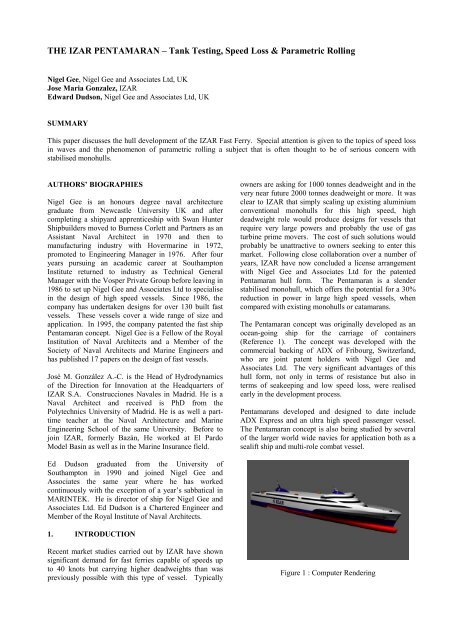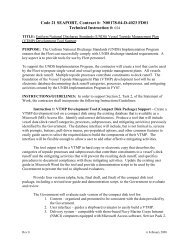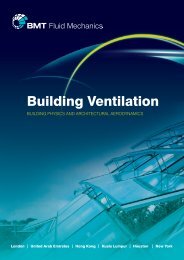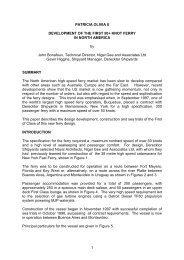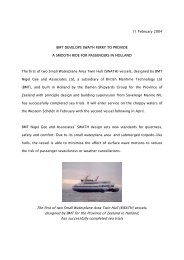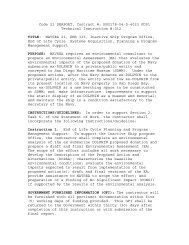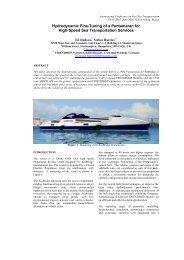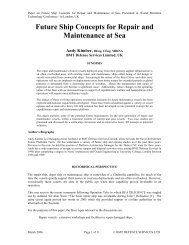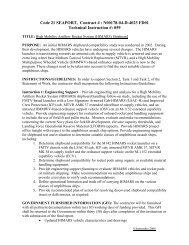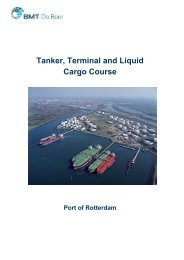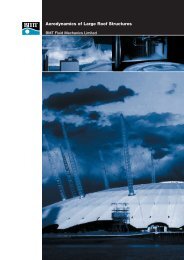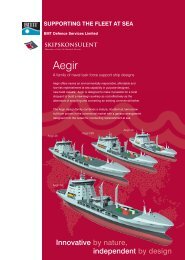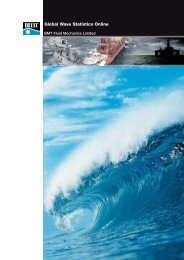THE IZAR PENTAMARAN – Tank Testing, Speed Loss ... - BMT Group
THE IZAR PENTAMARAN – Tank Testing, Speed Loss ... - BMT Group
THE IZAR PENTAMARAN – Tank Testing, Speed Loss ... - BMT Group
- TAGS
- izar
- pentamaran
You also want an ePaper? Increase the reach of your titles
YUMPU automatically turns print PDFs into web optimized ePapers that Google loves.
olling did not occur. This of course has a significantimpact on the powering of the vessel. <strong>IZAR</strong> weredetermined to investigate all possible problem areas ofthe pentamaran and therefore additional model tests wereperformed specifically to investigate the parametricrolling of the pentamaran.It is reported that this phenomenon is more probablewhen the encounter period is twice (parametric roll) orequal (synchronous roll) to the natural rolling period ofthe ship. It is also assumed that the ship will be moreprone to this parametric rolling if the resonanceconditions happen in combination with wave lengths,equal to the ship length because, in this case, thevariation in GM between crest and through is larger.Parametric roll must be thoroughly investigated whendesigning multihulled ships because it is known that thevariations in the magnitude of the metacentric height(GM) when sailing in waves are bigger for a multihullthan for a monohull vessel. The behaviour of monohulland multihull vessel also differs because, normally, themaxima of GM occur in the sagging condition for amonohull, where as these maxima appear for a multihullin hogging condition.Therefore, an important part of the model testingprogramme on the <strong>IZAR</strong> Fast Ferry , has been devoted tostudy the ship tendency to suffer parametric orsynchronous roll motions.It is so, that several conditions trying to gather at oncethe worse combinations of ship speeds, wave lengths,wave slopes, wave periods and encounter frequencieswere considered and four among them selected to betested at the model basin.First, the natural roll period for the ship in the water wasobtained trough roll decay tests performed for the ship atrest, as well as for the ship at a speed of 36 knots. Inorder to find the resonance conditions at speed, it hasbeen assumed a linear variation of the ship natural rollingperiod with the speed.Test conditions:AA.-BB.-CC.-DD.-Following waves, ship speed to get anencounter period equal to the ship naturalrolling period in order to check synchronousrolling inception. Regular wave length equal tothe ship length.Following waves, ship speed to get anencounter period equal to the ship naturalrolling period in order to check synchronousrolling inception. Regular wave length equal tothe ship length. Increased wave slope.Head waves, ship speed to get an encounterperiod equal to half the ship natural rollingperiod in order to check parametric rollinginception. Regular wave length equal to the shiplength.Head waves, ship speed to get an encounterperiod equal to half the ship natural rollingperiod in order to check parametric rollinginception. Large wave slope.The ship model was sailing free at the starting of eachrun and, later, the model was instantaneously forced toheel and released again in order to try to detect theinception of any rolling motion amplification. Thisinstantaneously excitation was repeated several timesalong the tank run and, always, the ship behavednormally being the externally generated roll motiondamped out similarly as observed during the standard rolldecay tests previously performed.Figures 2 and 3, depict samples of the time series of therolling motion recorded in the tested conditions called“BB” and “DD”.The external roll excitation is clearly in the time series.The ship rolling amplitudes are always small, being ofcourse smaller in head waves than in following wavesdue to a reduction of stability in following seas.The most relevant tested conditions are summarised inTable 6:Test condition (*) AA BB CC DDShip speed (kn) 6.3 6.3 16.7 1.3Ship heading (º) 0 0 180 180Wave period (s) 10.2 10.2 10.2 6.7Wave length (m) 162 162 162 70Wave height 4.1 5.4 5.4 3.5Slope (λ/H) 40 30 30 20Encounter period 12.5 12.5 6.25 6.25Looking for Synchr. Synchr. Param. Param.Table 6 - Parametric & Synchronous Roll <strong>Testing</strong>Figure 2 - Example of Time Series from tests DD


